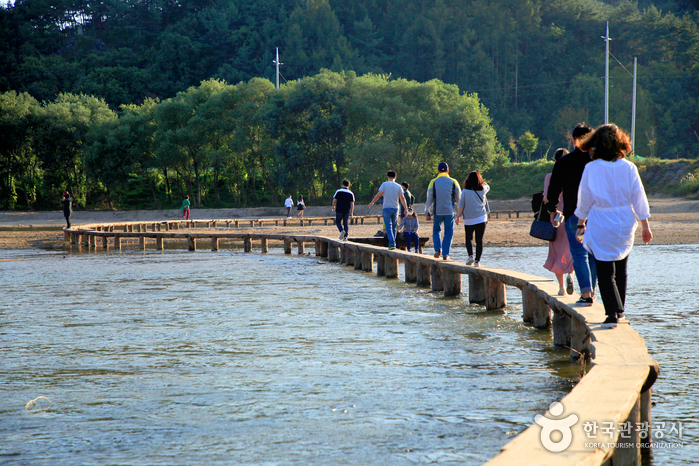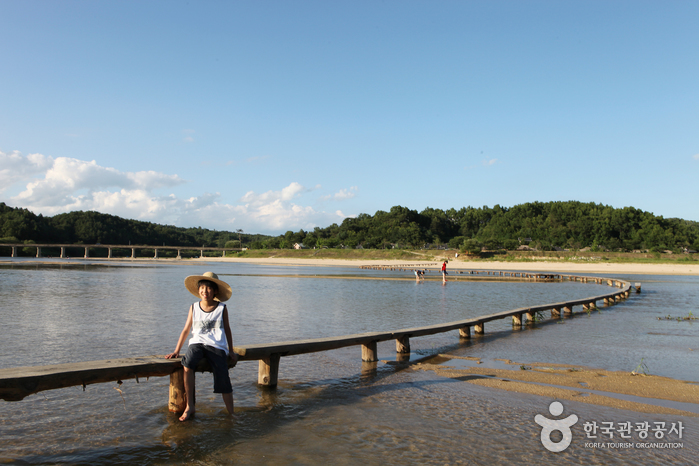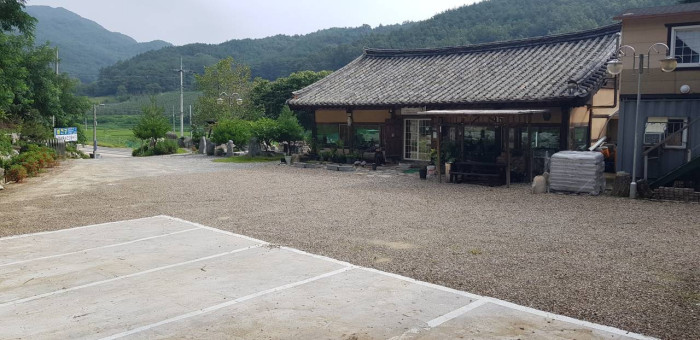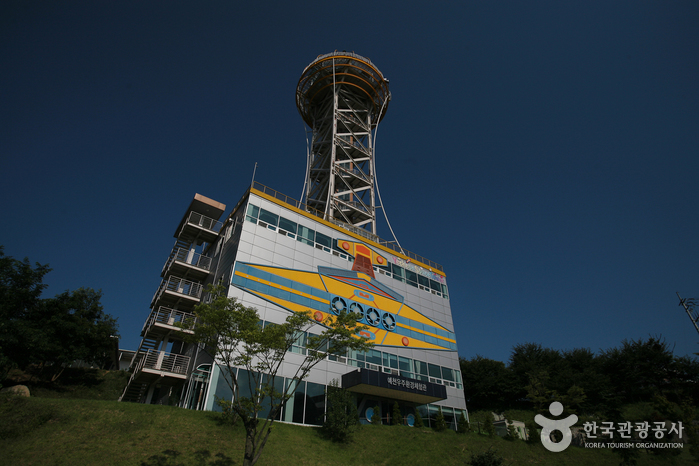Hakgasan Recreational Forest (학가산자연휴양림)
0m 24487 2021-06-15
210, Hyuyangnim-gil, Yecheon-gun, Gyeongsangbuk-do
+82-54-652-0114
Hakgasan Recreational Forest is located in a valley on the northern side of Hakgasan Mountain, known for its clean air. The recreational forest has log cabins that harmonize with the nearby trees, creeks, and rocks, making visitors feel as if they are resting at a luxury villa. It is an ideal vacation destination for those who want to get closer to nature. There is a hiking path leading to the summit of Hakgasan Mountain from the forest, taking around 2 hours. Additional amenities within the forest include campfire pits, an outdoor stage, children's playground, exercise equipment, water play area, a lecture hall, and more.
Bongjeongsa Temple [UNESCO World Heritage] (봉정사 [유네스코 세계문화유산])
6.4 Km 29829 2023-05-18
222, Bongjeongsa-gil, Andong-si, Gyeongsangbuk-do
+82-54-853-4181
Bongjeongsa Temple is believed to have been built in 672 by the Great Buddist Monk Uisang. However, other documents seem to state that Neungin Daedeuk, a disciple of Monk Uisang, established the temple. During the Korean War, many documents related to the temple were destroyed, so much of the history has been lost. In 1972, while reconstruction work was being done on Geungnakjeon Hall, records were discovered stating the hall was repaired in 1363. This discovery gave concrete evidence that Geungnakjeon Hall is the oldest wooden building in the nation.
Yeongju Museom Village (영주 무섬마을)
6.6 Km 21935 2021-08-24
31-12, Museom-ro 234beon-gil, Yeongju-si, Gyeongsangbuk-do
+82-54-638-1127
Located in Sudo-ri in Yeongju, Gyeongsangbuk-do, Museom Village is a charming hanok village surrounded by water. Flowing down from Sobaeksan Mountain and Taebaeksan Mountain, Naeseongcheon Stream and Yeongjucheon Stream converge and loop around Museom Village, surrounding the village on three sides with water. This peninsula-like village is not only the center of traditional Korean culture, but also has a gorgeous natural landscape complete with a wide sandy riverside and a lush inland forest.
Known for Haeudang and Manjukje Houses (two of the most historical hanok houses in the area), the village is also home to other outstanding traditional houses such as the Kim Gyu-jin House and the Kim Wi-jin House. Manjukje House is located at the heart of the village and the oldest traditional house in this hanok village. Manjukje was built in 1666 (7th year of King Heonjong's reign) by Bak Su (the father of the Bannam Bak Family).
Nearby Manjukje is Manun House, built in the early 19th century and named after Kim Hwi-geol (penname “Manun”). The house later became the home of the wife of the famous poet Jo Ji-hun, author of “Byeolli,” a poem expressing the beauty of Museom Village.
Other notable houses include the Kim Wi-jin House (a house belonging to aristocrats), the Kim Jeong-gyu House (a house without the traditional outer fencing), and the Bak Jae-yeon House, where the writings of Bak Gyu-su (a respected scholar during the Joseon period) still remain today.
Another famous attraction in the village is the Single Log Bridge, which was the village’s only connection to the outside world for over 350 years before the construction of Sudo Bridge in 1979. It is a tiny bridge in terms of x_width (30 cm), but it stretches for over 150 meters. It is said that the bridge was rebuilt annually after being destroyed each rainy season. With the construction of Sudo Bridge, the Single Log Bridge was no longer needed, but was rebuilt some time later in its original form. To celebrate the bridge’s impressive history, the village hosts the Single-Log Bridge Festival every October.
Manjukjae House[Korea Quality] / 만죽재 고택[한국관광 품질인증]
6.6 Km 0 2023-10-24
11-10 , Museom-ro 234beon-gil, Yeongju-si, Gyeongsangbuk-do
+82-54-638-1127
Manjukjae House is the oldest hanok in Museom Village, Yeongju, Gyeongsangbuk-do, with a history dating back 360 years. Originally built by Park Su to live the life of a reclusive gentleman after the Manchu Invasion of Korea, the house has been passed down from generation to generation through 13 generations. There are four guest rooms, Seomgye Chodang, Sarangchae (detached building), Anchae (main building), and Chaekbang (study), all of which can accommodate two people. Among them, Seomgye Chodang offers the best view, from where guests can enjoy the scenery of the log bridge in Museom Village, the Naeseongcheon Stream, and the white sandy beach. With the windows wide open, you can enjoy the cool breeze and the soothing sounds of nature.
Museom Single-Log Bridge Festival (무섬외나무다리축제)
6.6 Km 4862 2021-01-09
41, Museom-ro 234beon-gil, Yeongju-si, Gyeongsangbuk-do
• 1330 Travel Hotline: +82-2-1330 (Korean, English, Japanese, Chinese) • For more info: +82-54-630-8703
Museom Village is surrounded by water on three sides as it is located at the place where Naeseongcheon Stream (the upstream of Nakdonggang River) and Seocheon Stream meet. The village is called Sudori, or Museom, meaning an island in an inland area. It is a traditional village which has nine cultural assets, including Haeudang House (Folk Item No. 92).
The Museom Single-Log Bridge Festival, a landmark celebration of Yeongju, is held every October. The Museom Single-Log Bridge is one of the 100 most beautiful paths of Korea selected by the Ministry of Land, Transport and Maritime Affairs. The bridge is only 23-centimeters wide and it connects the village to the land across the stream surrounding it. The festival aims to preserve and promote the nation’s traditional culture. During the festival, one can enjoy and take part in a wide variety of folk events including the intramural Ssireum (traditional wrestling) Competition, Nongak (farmer’s music) Performance, Satto (chief of the village) Parade, crossing the bridge with a cow, a groom marching on a horse and a traditional wedding ceremony.
Jukheon Traditional House [Korea Quality] / 죽헌고택 [한국관광 품질인증]
7.1 Km 513 2023-09-05
24 , Taejangjukheon-gil, Andong-si, Gyeongsangbuk-do
+82-10-5217-2174
Jukheon Old House is an old house near Bongjeongsa Temple in Andong, Gyeongsangbuk-do. Originally built in 1886 by independence activist Kim Ga-jin, it was later acquired by Jukheon Lee Hyeon-chan and until recently was used as a family gathering place for jaesa ancestral rites. There are three 2-person guestrooms (Jukheon Gallery Room, Seojae Room and Elizabeth Room) and one four-person room (Jukheon-dong Farm Room). Visitors can explore the old thatched millhouse with its ancient treadmill, or enjoy a walk along Queen Elizabeth Road to Bongjeongsa Temple. A simple complimentary breakfast is provided.
Byeolcheongung (별천궁)
7.7 Km 51 2021-03-30
141, Bongjeongsa-gil, Andong-si, Gyeongsangbuk-do
+82-54-857-4168
It is a restaurant with a hanok interior. This restaurant's signature menu is set menu with grilled salted mackerel. This Korean dishes restaurant is located in Andong-si, Gyeongsangbuk-do.
Yecheon Astro-Space Center (예천천문우주센터)
8.2 Km 14850 2021-12-23
1078, Chunghyo-ro, Yecheon-gun, Gyeongsangbuk-do
+82-54-654-1710
Yecheon Astro-Space Center is a theme park that opened in November 2004. The Yecheon Astronomical Science and Culture Center has built and operated the Yecheon Star Observatory. Visitors can stay in the accommodations in the park, observe the distant universe through a large telescope, and experience the space environment such as weightlessness.
In the observation room, visitors can observe the appearance of the universe with a 508 mm (20 inch) reflecting telescope that is automatically controlled by a computer. In the auxiliary observation room, visitors can observe sunspots and huge pillars of fire on the surface of the sun with a quadruple solar telescope. The astronomical projection room is a 'space theater' where a digital astronomical projector and video projector are installed, and images related to the astronomical universe, including seasonal constellations, are screened on a hemispherical dome screen on the ceiling.
At the Yecheon Star Observatory, visitors can observe the pillars of fire that soar through the sun during the day and sunspots that are larger than Earth. At night, visitors can observe the galaxy, the nebula, where stars born and die, as well as star clusters, and the moon, which is the closest celestial body to Earth, has large and small meteorite craterson the surface. There are many more fun experiences at the Yecheon Star Observatory.
Dojeong [Korea Quality] / 도정서원 [한국관광 품질인증]
8.2 Km 319 2023-11-30
417 , Gangbyeon-ro, Yecheon-gun, Gyeongsangbuk-do
+82-10-3451-9900
Dojeong Seowon in Yecheon, Gyeongsangbuk-do, was built to honor Yakpo Jeong Tak, who saved the life of the famous Admiral Yi Sunshin back in the 1500s. Now a hanok stay, it has four guest rooms, including Gangdang, once used as a lecture hall by Joseon scholars; a pavilion called Eup-hojeong; and Dongjae and Seojae, which were once dormitories. Gangdang is a private house of about 100 square metres and is suitable for group travelers. Eup-hojeong stands on a bluff overlooking the stream. Dongjae and Seojae have their own bathrooms. Standing on the 2nd floor of the pavilion brings one to the view of the Naeseongcheon Stream flowing in an arc around the mountain.
An dong gotak Esanru [Korea Quality] / 안동고택 이상루 [한국관광 품질인증]
8.9 Km 14594 2023-09-01
3193-6 , Pungsantaesa-ro, Andong-si, Gyeongsangbuk-do
+82-10-3522-1542
Andong Old House Lee Sangnu stands at the foot of Cheondeungsan Mountain in Andong, Gyeongsangbuk-do. The house has a 250-year history and is still used for family rituals commemorating the founder of the Andong Kim Clan. Lee Sangnu is a dignified two-story wooden pavilion with an attic, while at Yisangru visitors can set a fire in the fire pit in the winter or sleep in a tent or mosquito net in the summer. Cultural programs are available: tea ceremonies, knot craft, the mask dance, natural dyeing, Korean paper craft, and learning about filial piety. The Old House’s location between Andong Hahoe Village and Dosan Seowon makes it convenient for local site-seeing.

![Bongjeongsa Temple [UNESCO World Heritage] (봉정사 [유네스코 세계문화유산])](http://tong.visitkorea.or.kr/cms/resource/16/2654216_image2_1.jpg)

![Manjukjae House[Korea Quality] / 만죽재 고택[한국관광 품질인증]](http://tong.visitkorea.or.kr/cms/resource/55/3016955_image2_1.jpg)

![Jukheon Traditional House [Korea Quality] / 죽헌고택 [한국관광 품질인증]](http://tong.visitkorea.or.kr/cms/resource/33/2993133_image2_1.jpg)


![Dojeong [Korea Quality] / 도정서원 [한국관광 품질인증]](http://tong.visitkorea.or.kr/cms/resource/58/3037058_image2_1.jpg)
![An dong gotak Esanru [Korea Quality] / 안동고택 이상루 [한국관광 품질인증]](http://tong.visitkorea.or.kr/cms/resource/94/2993094_image2_1.jpg)
 English
English
 한국어
한국어 日本語
日本語 中文(简体)
中文(简体) Deutsch
Deutsch Français
Français Español
Español Русский
Русский